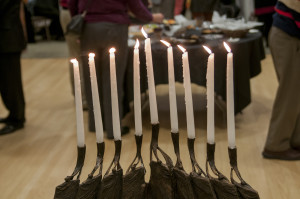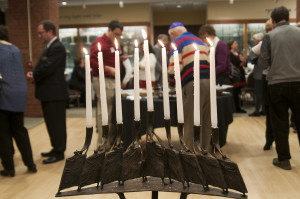
Hanukkah at TBK
photo by Eli Landesberg
To celebrate the eighth night of Hanukkah, Temple B’rith Kodesh issued an invitation to “light the candles with interfaith and community guests.” On Sunday, we gather in the attractive Atrium with its large collection of Menorahs from all over the world, representing centuries of artistic/artisan creativity. The collection infuses the space with intimate history and a presence of ancestors that encircle/embrace the local Hanukkah event. Ready to light the candles, Rabbis Peter Stein and Kelly Levy are joined by Bill Moehle, the Brighton Town Supervisor and we the people of different faith communities chant the traditional Hanukkah blessings.

Hanukkah at TBK
photo by Eli Landesberg
The Menorah, beautiful with its bright eight candles emanates the light of oneness. Placing food on plates people introduce themselves, and mention their places of worship; animated conversations permeate the Atrium and some people tell me that they have joined Hanukkah celebrations in the past and they connect to its message of freedom. I am aware of how important an interfaith celebration is these days, when American religious freedom has come under attack. There has been anti Muslim rhetoric against Muslim American citizens, there were attacks on women wearing the hijab, and defiling graffiti and burning of mosques.
The recent attacks on Muslim Americans echo the kind of acts from which our ancestors of different denominations and faith communities escaped. They came to Colonial America because it was the place of refuge from European religious wars and persecutions. I look again at the Menorah and think of the role of the ninth candle, the server, the Shamash, the one candle that lights all the other candles*. It is the freedom candle that lit a historic ongoing American journey. It started with religious freedom inscribed in legal documents, in the Constitution, ‘No religious test shall ever be required as a qualification to any office or public trust under the United States’ (Article VI, September 17, 1787) and in the First Amendment, ‘Congress shall make no law respecting an establishment of religion’ (December 15, 1791).
In addition to these documents there were numerous letters written to President George Washington after the publication of the Constitution and before the insertion of the First Amendment. The letters to ensure religious freedom were written by the clergy of a number of denominations to the first president who wrote back with assurances. Among them were the letters exchanged between the Hebrew Congregation Yeshuat Israel in Newport Rhode Island and George Washington. The president wrote to the Jewish community that America has “a Government, which to bigotry gives no sanction, to persecution no assistance.” The letter was entered into the Congressional Record and George Washington’s words became part of America’s legal promise of religious freedom and a promissory note of freedom from slavery and down the road for civil rights for all its citizens.
America’s promise as an ongoing freedom journey thus graces our 2015 Hanukkah celebration and frames Rabbi Stein’s words, “I pray that the light of our Menorahs will not just be the light of the candles, but will be a symbolic reminder to work for the cause of peace,” adding that Hanukkah is an inspiring festival marking our pursuit of freedom and peace. Freedom and peace need constant reminding and minding. When we celebrate Hanukkah together we know that human rights here and around the world must give contemporary meaning to the verse from the book of Isaiah, “My House will be called a house of prayer for all the peoples.”
*Thanks to my brother David for drawing my attention of the role of the ninth candle as leader and leading.
Thanks to Eli Landesberg for his photos.